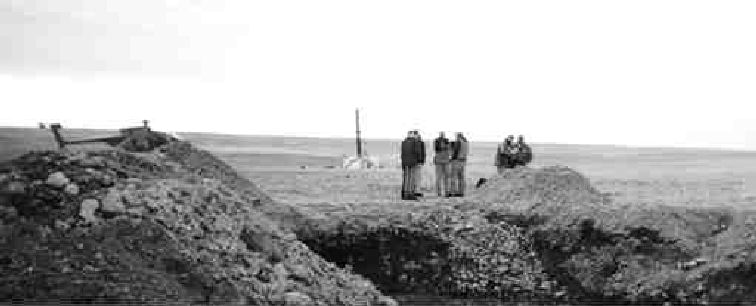Mini-bulk kimberlite samples gathered by
At this stage, the resource potential of the Freightrain prospect remains unclear. Last year’s delineation drilling program failed to define the body. Twin drilled a series of 17 short holes into Freightrain but was unable to penetrate to depth to any degree. Fifteen of the holes intersected a total of just 314 metres of kimberlite, with 14 of the holes ending in limestone.
The Freightrain prospect outcrops as a series of 16 weathered kimberlite showings interspersed with predominant limestone bocks or rafts within a 500-metre-diameter area. In conjunction with last summer’s drilling, Twin collected a total of 228.19 tonnes of blasted kimberlite from six sample sites. A total of 869 diamonds weighing 46.21 carats were recovered by Lakefield Research, using a 0.8-mm lower-size cutoff. The six sample sites produced variable grades, ranging from 0.106 to 0.336 carat per tonne, for an average of 0.202 carat per tonne.
The largest recovered stone is gem-quality and 1.56 carats, measuring 7.1 by 6.27 by 3.94 mm. The next four biggest stones weigh 0.936, 0.87, 0.867 and 0.809 carat.
Now that a larger parcel of stones from Freightrain has been recovered, Lakefield’s manager of mineralogical services, Bruce Jago, says he definitely sees some boart, or non-gem quality, stones.
The boart comprises a fairly low proportion of the overall parcel. A lot of these stones are strongly resorbed, meaning they have lost a fair bit of diamond, leading Jago to believe that the boart and the uglier, structurally less-sound stones might break up and dissolve far more easily than the durable, gem-quality stones.
Jago says diamonds could dissolve in the mantle if conditions border between the diamond and graphite stability field or if oxidizing fluids flux through the mantle. Diamonds can also be “resorbed” during kimberlite emplacement into the upper crust if, for whatever reason, the kimberlite becomes more oxidizing.
“It is not uncommon in kimberlites to get resorption,” says Jago. “The Northwest Territories and Russia aren’t bothered by it so much, but the South Africa stones certainly have this.”
Twin plans to return to the Jackson Inlet project this summer and drill several untested airborne magnetic anomalies defined by last year’s 6,641-line-km helicopter-borne survey. Flown at a line spacing of 250 metres, the magnetic survey revealed 14 anomalies, including Freightrain and the Cargo 1 pipe.
The field season will start with ground follow-up work on the anomalies, including till sampling and further geophysics. Twin has hired AMEC’s E&C Services (formerly MRDI) to review the Freightrain diamond results from the perspective of diamond distribution and reproducibility of results. AMEC will also advise Twin on a suitable site for the extraction of a larger bulk sample from the Freightrain prospect, as well as determine how much of a sample to take. “Obviously, we have to get a better feel for the geometry and subsequently an idea of the resource,” says Twin President Hermann Derbuch.
The company has roughly $2.5 million in cash and 73.4 million shares outstanding.


Be the first to comment on "Lower-grade Freightrain yields gem-quality stones"